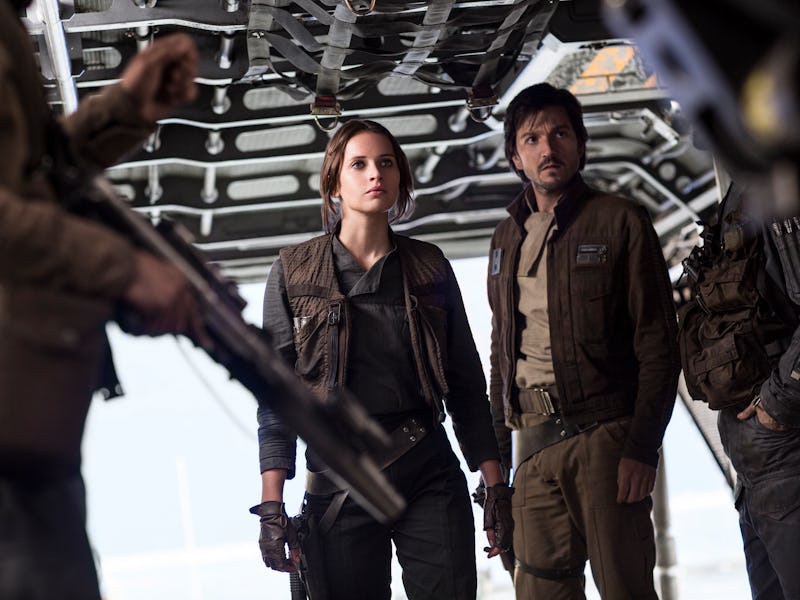John Knoll Forever Changed 'Star Wars' During Lunch
An ILM VFX expert wanted to see the "military industrial complex of the Empire."

Every great origin story has its own special origin story, and Rogue One is no exception: The new Star Wars movie was born in a cafeteria in the suburbs of San Francisco.
“The story had grown over the course of a couple of weeks when, very naturally, the topic of these new [standalone] Star Wars films was a big discussion point at lunch with friends,” John Knoll, now the Chief Creative Officer at Lucasfilm’s visual effect company ILM, told Inverse. The company had internally announced that it would be producing a Han Solo origin story, and Knoll felt as if there was a lot of fertile ground further out in the galaxy. “Just talking with friends, I’d say, ‘I think we’re missing an opportunity if we don’t also explore stories that don’t necessarily have any characters that we are familiar with, and that tell a compelling story in the Star Wars universe.’”
Knoll began his career at ILM back in 1984, right as Return of the Jedi was being completed. He was the visual effects supervisor on the prequel trilogy, and was bumped up to Chief Creative Officer shortly after Disney bought Lucasfilm in 2012. So when he talked around the cafeteria, people obviously listened. And it helped that new Lucasfilm CEO Kathy Kennedy had, at least inadvertently, blessed the creative license he was taking.
“Kathy had said at the time that we may explore different genres. One might be a western; one might be a war film. So I started pitching very informally this idea,” Knoll recalled. “It was: ‘Imagine SEAL Team Six in the Star Wars universe. A group of Rebel commandos that go on a desperate mission to penetrate the most secure facility at the heart of the military industrial complex of the Empire to steal the Death Star plans.’ And I got a lot of intrigued responses, and in each telling it got a little bit more elaborate, with more characters and more of the plot structure.”
The kernel of Knoll’s idea actually originated back during the mid-2000s, when Lucasfilm announced that it was was developing a live-action Star Wars TV series. Nothing came of that show, but after the Disney acquisition, the movies were full-steam ahead. All the while, Knoll had held strong to the belief that inspired his initial concept all those years ago: “The formula you need to have to be a Star Wars film doesn’t necessarily include a lightsaber and Jedi,” he told people, adding that, “I think we can be bolder with these experiments.”
So the pitch grew and grew around the lunch tables at ILM, until a friend at the company suggested he actually go present his idea to Kennedy herself. “As soon as he said that, I thought, he’s right, because if I don’t, I’ll always wonder what would have happened if I had,” Knoll recalled.
Given his stature in the company, getting a meeting with Kennedy wasn’t a problem — but getting it on the calendar, that was another story. It took six weeks from the moment he called for the appointment to actually get into her office. “I used that time to flesh out [the story] and put it in writing,” Knoll said. “I wrote out a six page treatment about what the events were, who the central characters were, the central themes that ran through the narrative.”
After over 30 years in Hollywood, working on some of the biggest blockbusters in history, this would be the first story pitch he’d ever deliver. And it was a bold one: At the core of his pitch was the idea that Star Wars fans didn’t need their favorite characters to care about a movie.
“The big thing here is instead of centering it on a character we know, we center it on an event people know of,” he said. “It’s briefly mentioned in the opening crawl of Star Wars, this idea of the Rebel spies stealing the Death Star plans, while a big space battle is underway. I thought it’s a really cool idea and could be expanded into something that could be really compelling. It was that hook into the events of Star Wars as we know, and I thought, that could carry the film.”
Despite having known Kennedy from past projects together — she was a producer on the Indiana Jones movies, on which ILM worked — Knoll said his pitch received a polite reception. Kennedy called it “intriguing” and “impressive,” but that was about it.
It was another week or so before Knoll got a call from Kiri Hart, the head of the Star Wars story group: They were all-in. Writer Gary Whitta and director Gareth Edwards came on board next, and the rest is history. Nearly $1 billion in box office earnings later, Knoll no longer has to explain his vision. It speaks for itself.